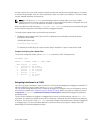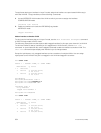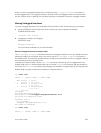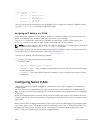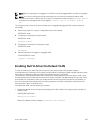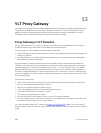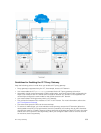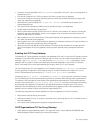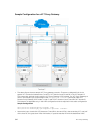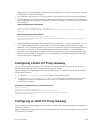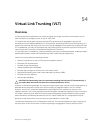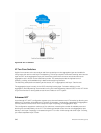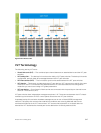• If the port-channel specified in the proxy-gateway command is not a VLT LAG, the configuration is
rejected by the CLI.
• You cannot change the VLT LAG to a legacy LAG when it is part of proxy-gateway.
• You cannot change the link layer discovery protocol (LLDP) port channel interface to a legacy LAG
when you enable a proxy gateway.
• Dell Networking recommends the vlt-peer-mac transmit command only for square VLTs
without diagonal links.
• The virtual router redundancy (VRRP) protocol and IPv6 routing is not supported.
• Private VLANs (PVLANs) are not supported.
• When a Virtual Machine (VM) moves from one VLT domain to the another VLT domain, the VM host
sends the gratuitous ARP (GARP) , which in-turn triggers a mac movement from the previous VLT
domain to the newer VLT domain.
• After a station move, if the host sends a TTL1 packet destined to its gateway; for example, a previous
VLT node, the packet can be dropped.
• After a station move, if the host first PINGs its gateway; for example, a previous VLT node it results in a
40 to 60% success rate considering it takes a longer path.
• When you remove and add back a MAC address, L3 frames can be received out-of-order at the L3
cloud. This happens when proxy gateway routing and sub-optimal routing intersperse with each
other.
Enabling the VLT Proxy Gateway
To enable the VLT proxy gateway, the system mac addresses of C and D in the local VLT domain must be
installed in C1 and D1 in the remote VLT domain and vice versa. You can install the mac address in two
methods - the proxy-gateway lldp method or the proxy-gateway static configuration. Proxy-
gateway LLDP is a dynamic method of installing the local mac addresses in the remote VLT domain,
which is achieved using a new organizational type, length, value (TLV) in LLDP packets.
You can configure the VLT proxy gateway in a VLT domain using the proxy-gateway LLDP command
in proxy-gateway Configuration mode. Specify the port-channel interface of the square VLT link on
which LLDP packets are sent using the
peer-domain-link port-channel command.
Configuring the proxy gateway lldp and the peer-domain-link port channel, LLDP sets TLV flags
on the interfaces for receiving and transmitting private TLV packets. After defining these organizational
TLV settings, LLDP encodes the local system mac-addresses as organizational TLVs for transmitting to
the peer. If you specify the no proxy gateway LLDP interface command, LLDP stops transmitting
and receiving proxy gateway TLV packets on the specified interfaces. However, other TLVs are not
affected. From the interfaces on which you enabled the proxy gateway LLDP, LLDP decodes the TLV
packets from the remote LLDP by using the new organizational TLV.
The following requirements must be satisfied for LLDP proxy gateway to function correctly:
• Data centers must be directly connected.
• LLDP has a limited TLV size. As a result, information that is carried by the new TLV is limited to one or
two MAC addresses.
• You must have all related systems properly configured and set up.
LLDP Organizational TLV for Proxy Gateway
• LLDP defines an organizationally specific TLV (type 127) with a unique identifier (0x0001E8) and a
defined subtype (0x01) for sending or receiving information.
940
VLT Proxy Gateway




